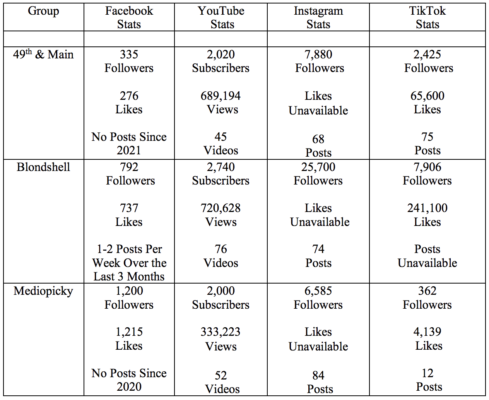In today’s world, artists have more options than ever before to find success. There is more technology to both create their content and connect with others, helping to expand their reach. Said content can become more complex and intricate through online resources, which help to create new visuals and sounds that weren’t thought possible before. Through social media, artists can widely promote and share their work. They are able to give and take inspiration to and from others, while collaborating with them. There is also the issue of distribution and being part of a network in order to expand one’s audience, granting even more opportunities. The following report is an overview of how indie artists, specifically 49th & Main, Blondshell, and Mediopicky have used the resources available to create and share their content.
The predominant tool that up-and-coming artists utilize is social media. Whether it is Facebook, Instagram, TikTok, YouTube, or anything in between, social media is easily accessible and far-reaching. The Indie-Pop band, 49th & Main, is a prime example of this. They routinely use their Instagram feed to share highlights from their performances. These posts tend to be more frequent when they are on tour, which often has them performing at local festivals. Additionally, 49th & Main uses Instagram and TikTok to share short videos of their personal and professional lives. They often tie these videos into an album or single they are releasing, potentially with a preview from one of these projects.
Similarly, the rising artist “Blondshell” frequently shares excerpts from her work. Both Blondshell and 49th & Main utilize Facebook, although they tend to cross-post content that is on their more popular platforms. Although younger audiences use Facebook less frequently, the purpose is likely to expand their reach to those who may not utilize some of the more popular and trending platforms. In short, artists use many forms of social media to both share and create excitement for their work.
Another topic that appears to be undergoing change is the form and function of music videos. Previously, music videos have told stories, but with the technology that is available today, artists can create visuals that were not possible before. Pablo Alcantara, known as Mediopicky, is an artist from the Dominican Republic who specializes in combining electronic and synth sounds, resulting in a uniqueness that he has built his reputation around. He, along with many other artists, uses a tool in videos called a visualizer. This creates more of a slow moving picture than an actual video with different cuts and angles. Visualizers are often very inexpensive, if not free, allowing artists with a smaller budget to still portray the message of their songs. Mediopicky utilized this in one of his more recent songs, “Who am yo?” The song raises questions about identity and feeling lost in the world. The frame constantly shifts from one version of himself to another, which implies that he is unsure of who he is and who he wants to be. Without creating a “traditional” music video, Mediopicky was still able to effectively portray his complex themes and messages. However, traditional music videos are still extremely relevant, and can be created with any kind of camera. There doesn’t need to be any special effects, such as what Blondshell did with her newest release, “Salad.” She simply went to different locations and filmed herself while the music played in the background. Therefore, while music videos are still very relevant, there are now different options available to artists regarding how to make them and what their purposes are.
Regarding distribution, artists from all over would benefit greatly from being a part of Vevo, which bills itself as the world’s leading music video network. It receives 25 billion views and has 1.5 billion hours of content viewed per month, and hosts over 500,000 music videos. Vevo is a network that brings in all kinds of artists, including indie, rap, rock, and hip-hop. Many people may recognize the name as being associated with music video titles on YouTube, but it can be accessed from many different sources of entertainment, such as Hulu and Prime Video. Vevo is an opportunity for artists to belong to a large distribution network that cross-promotes their own clients. Additionally, Vevo gives their artists more money than YouTube per view, allowing them to grow at an accelerated rate. Clearly, this is a great tool that artists should strive to be a part of, and many are such as 49th & Main. However, Blondshell and Mediopicky are not part of Vevo. They would greatly benefit from joining the platform due to its vast reach and growth potential.
In conclusion, many artists are using tools to gain popularity and grow their fanbase. They take advantage of social media to its fullest, using it as both self-promotion and an opportunity to try and collaborate with others. Additionally, the idea of a music video is still legitimate, and is having its structure altered by those who would benefit most from a change, whether for budgetary reasons or otherwise. Finally, there are new and, for some, very exciting networking and distribution methods, such as Vevo. In short, indie artists have great potential to grow at an unprecedented rate due to the ease of access to effective resources.
by Andrew Tomasino, Innsbruck Records Intern, Summer 2023






